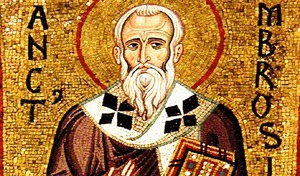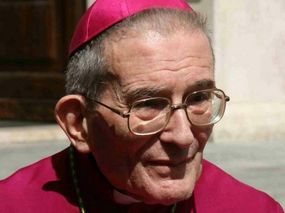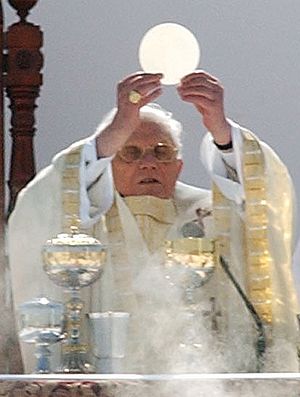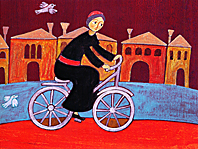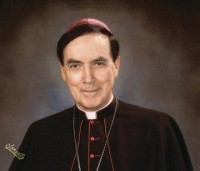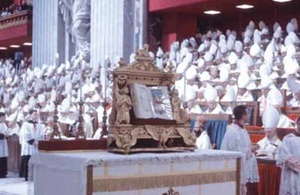This morning in Rome, Pope Benedict opened the 13th Ordinary Synod of Bishops whose it will be to guide him and the entire Church, in the work of Evangelization. At Holy Mass, His Holiness bestowed the honor of being Doctors of the Church on Saint John of Avila and Saint Hildegard of Bingen. The Pope’s homily follows.
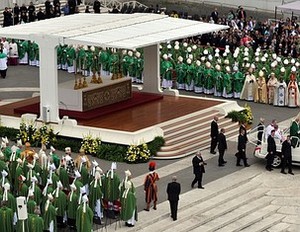
With this solemn concelebration we open the thirteenth Ordinary General Assembly of the Synod of Bishops on the theme The New Evangelization for the Transmission of the Christian Faith. This theme reflects a programmatic direction for the life of the Church, its members, families, its communities and institutions. And this outline is reinforce by the fact that it coincides with the beginning of the Year of Faith, starting on 11 October, on the fiftieth anniversary of the opening of the Second Vatican Ecumenical Council. I give a cordial and grateful welcome to you who have come to be part of the Synodal Assembly, in particular to the Secretary-General of the Synod of Bishops, and to his colleagues. I salute the fraternal delegates of the other churches and ecclesial communities as well as all present, inviting them to accompany in daily prayer the deliberations which will take place over the next three weeks.
The readings for this Sunday’s Liturgy of the Word propose to us two principal points of reflection: the first on matrimony, which I will touch shortly; and the second on Jesus Christ, which I will discuss now. We do not have time to comment upon the passage from the Letter to the Hebrews but, at the beginning of this Synodal Assembly, we ought to welcome the invitation to fix our gaze upon the Lord Jesus, “crowned with glory and honour, because of the suffering of death (2:9). The word of God places us before the glorious One who was crucified, so that our whole lives, and in particular the commitment of this Synodal session, will take place in the sight of him and in the light of his mystery. In every time and place, evangelization always has as its starting and finishing points Jesus Christ, the Son of God (cf. Mk 1:1); and the Crucifix is the supremely distinctive sign of him who announces the Gospel: a sign of love and peace, a call to conversion and reconciliation. My dear Brother Bishops, starting with ourselves, let us fix our gaze upon him and let us be purified by his grace.
I would now like briefly to examine the new evangelization, and its relation to ordinary evangelization and the mission ad Gentes. The Church exists to evangelize. Faithful to the Lord Jesus Christ’s command, his disciples went out to the whole world to announce the Good News, spreading Christian communities everywhere. With time, these became well-organized churches with many faithful. At various times in history, divine providence has given birth to a renewed dynamism in Church’s evangelizing activity. We need only think of the evangelization of the Anglo-Saxon peoples or the Slavs, or the transmission of the faith on the continent of America, or the missionary undertakings among the peoples of Africa, Asia and Oceania. It is against this dynamic background that I like to look at the two radiant figures that I have just proclaimed Doctors of the Church, Saint John of Avila and Saint Hildegard of Bingen. Even in our own times, the Holy Spirit has nurtured in the Church a new effort to announce the Good News, a pastoral and spiritual dynamism which found a more universal expression and its most authoritative impulse in the Second Vatican Ecumenical Council. Such renewed evangelical dynamism produces a beneficent influence on the two specific “branches” developed by it, that is, on the one hand the Missio ad Gentes or announcement of the Gospel to those who do not yet know Jesus Christ and his message of salvation, and on the other the New Evangelization, directed principally at those who, though baptized, have drifted away from the Church and live without reference to the Christian life. The Synodal Assembly which opens today is dedicated to this new evangelization, to help these people encounter the Lord, who alone who fills our existence with deep meaning and peace; and to favour the rediscovery of the faith, that source of grace which brings joy and hope to personal, family and social life. Obviously, such a special focus must not diminish either missionary efforts in the strict sense or the ordinary activity of evangelization in our Christian communities, as these are three aspects of the one reality of evangelization which complement and enrich each other.
The theme of marriage, found in the Gospel and the first reading, deserves special attention. The message of the word of God may be summed up in the expression found in the Book of Genesis and taken up by Jesus himself: “Therefore a man leaves his father and his mother and cleaves to his wife, and they become one flesh” (Gen 2:24; Mk 10:7-8). What does this word say to us today? It seems to me that it invites us to be more aware of a reality, already well known but not fully appreciated: that matrimony is a Gospel in itself, a Good News for the world of today, especially the dechristianized world. The union of a man and a woman, their becoming “one flesh” in charity, in fruitful and indissoluble love, is a sign that speaks of God with a force and an eloquence which in our days has become greater because unfortunately, for various reasons, marriage, in precisely the oldest regions evangelized, is going through a profound crisis. And it is not by chance. Marriage is linked to faith, but not in a general way. Marriage, as a union of faithful and indissoluble love, is based upon the grace that comes from the triune God, who in Christ loved us with a faithful love, even to the Cross. Today we ought to grasp the full truth of this statement, in contrast to the painful reality of many marriages which, unhappily, end badly. There is a clear link between the crisis in faith and the crisis in marriage. And, as the Church has said and witnessed for a long time now, marriage is called to be not only an object but a subject of the new evangelization. This is already being seen in the many experiences of communities and movements, but its realization is also growing in dioceses and parishes, as shown in the recent World Meeting of Families.
One of the important ideas of the renewed impulse that the Second Vatican Council gave to evangelization is that of the universal call to holiness, which in itself concerns all Christians (cf. Lumen Gentium, 39-42). The saints are the true actors in evangelization in all its expressions. In a special way they are even pioneers and bringers of the new evangelization: with their intercession and the example of lives attentive to the inspiration of the Holy Spirit, they show the beauty of the Gospel to those who are indifferent or even hostile, and they invite, as it were tepid believers, to live with the joy of faith, hope and charity, to rediscover the taste for the word of God and for the sacraments, especially for the bread of life, the Eucharist. Holy men and women bloom among the generous missionaries who announce the Good News to non-Christians, in the past in mission countries and now in any place where there are non-Christians. Holiness is not confined by cultural, social, political or religious barriers. Its language, that of love and truth, is understandable to all people of good will and it draws them to Jesus Christ, the inexhaustible source of new life.
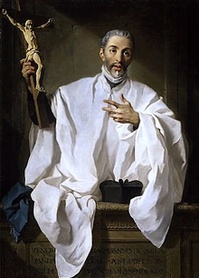
At this point, let us pause for a moment to appreciate the two saints who today have been added to the elect number of Doctors of the Church. Saint John of Avila lived in the sixteenth century. A profound expert on the sacred Scriptures, he was gifted with an ardent missionary spirit. He knew how to penetrate in a uniquely profound way the mysteries of the redemption worked by Christ for humanity. A man of God, he united constant prayer to apostolic action. He dedicated himself to preaching and to the more frequent practice of the sacraments, concentrating his commitment on improving the formation of candidates for the priesthood, of religious and of lay people, with a view to a fruitful reform of the Church.

Saint Hildegard of Bingen, an important female figure of the twelfth century, offered her precious contribution to the growth of the Church of her time, employing the gifts received from God and showing herself to be a woman of brilliant intelligence, deep sensitivity and recognized spiritual authority. The Lord granted her a prophetic spirit and fervent capacity to discern the signs of the times. Hildegard nurtured an evident love of creation, and was learned in medicine, poetry and music. Above all, she maintained a great and faithful love for Christ and his Church.
This summary of the ideal in Christian life, expressed in the call to holiness, draws us to look with humility at the fragility, even sin, of many Christians, as individuals and communities, which is a great obstacle to evangelization and to recognizing the force of God that, in faith, meets human weakness. Thus, we cannot speak about the new evangelization without a sincere desire for conversion. The best path to the new evangelization is to let ourselves be reconciled with God and with each other (cf. 2 Cor 5:20). Solemnly purified, Christians can regain a legitimate pride in their dignity as children of God, created in his image and redeemed by the precious blood of Jesus Christ, and they can experience his joy in order to share it with everyone, both near and far.
Dear brothers and sisters, let us entrust the work of the Synod meeting to God, sustained by the communion of saints, invoking in particular the intercession of great evangelizers, among whom, with much affection, we ought to number Blessed Pope John Paul II, whose long pontificate was an example of the new evangelization. Let us place ourselves under the protection of the Blessed Virgin Mary, Star of the New Evangelization. With her let us invoke a new outpouring of the Holy Spirit, that from on high he may illumine the Synodal assembly and make it fruitful for the Church’s journey today, in our time. Amen.
